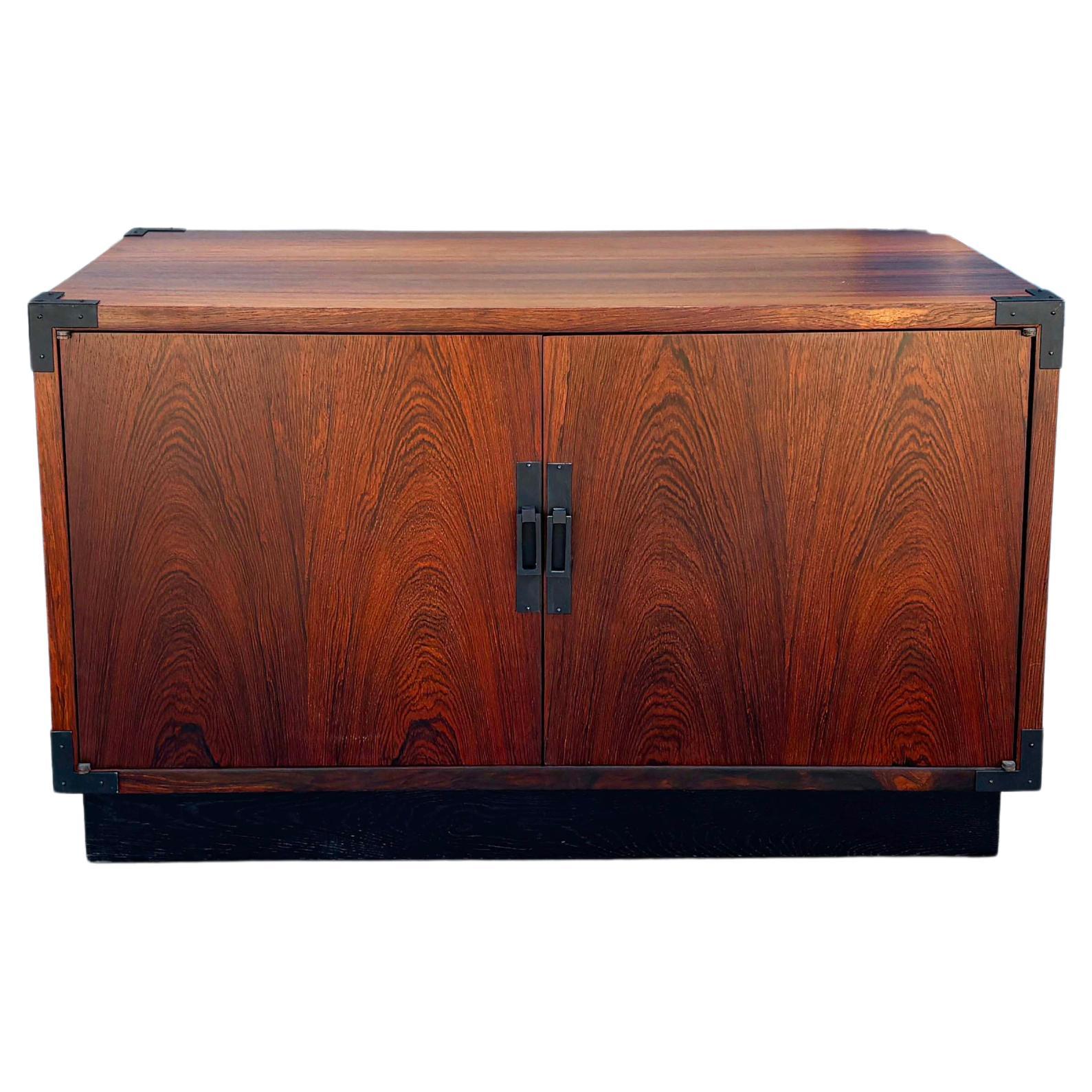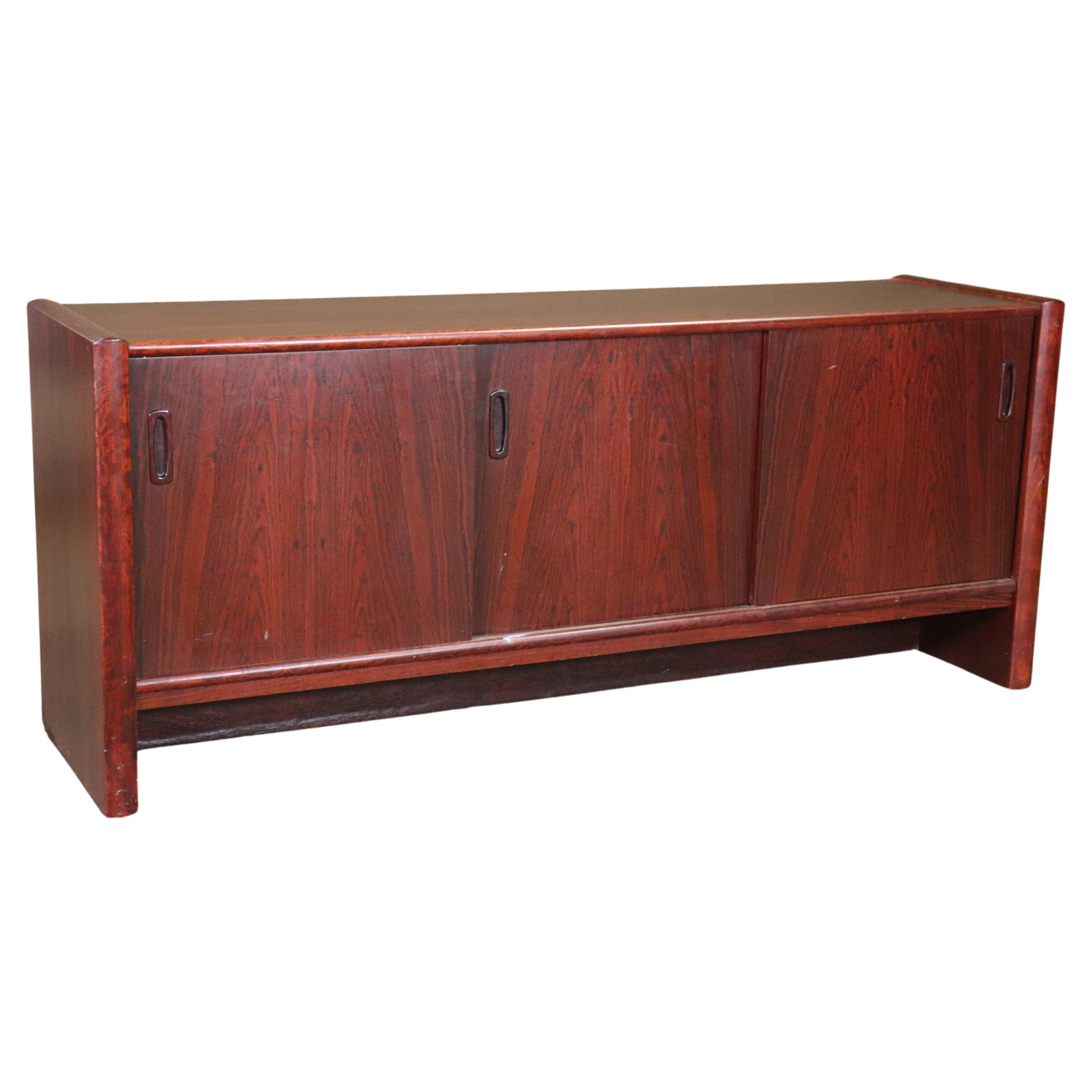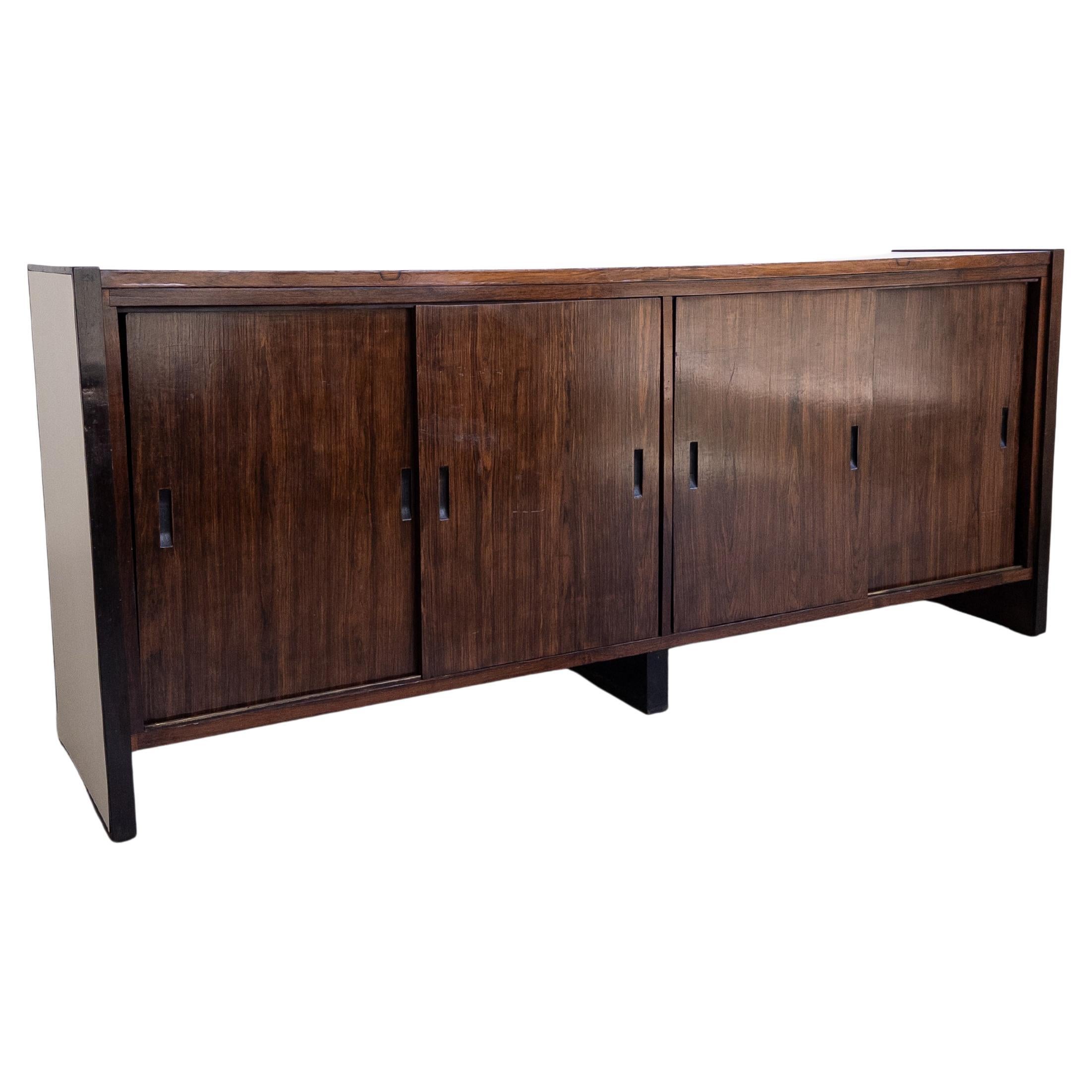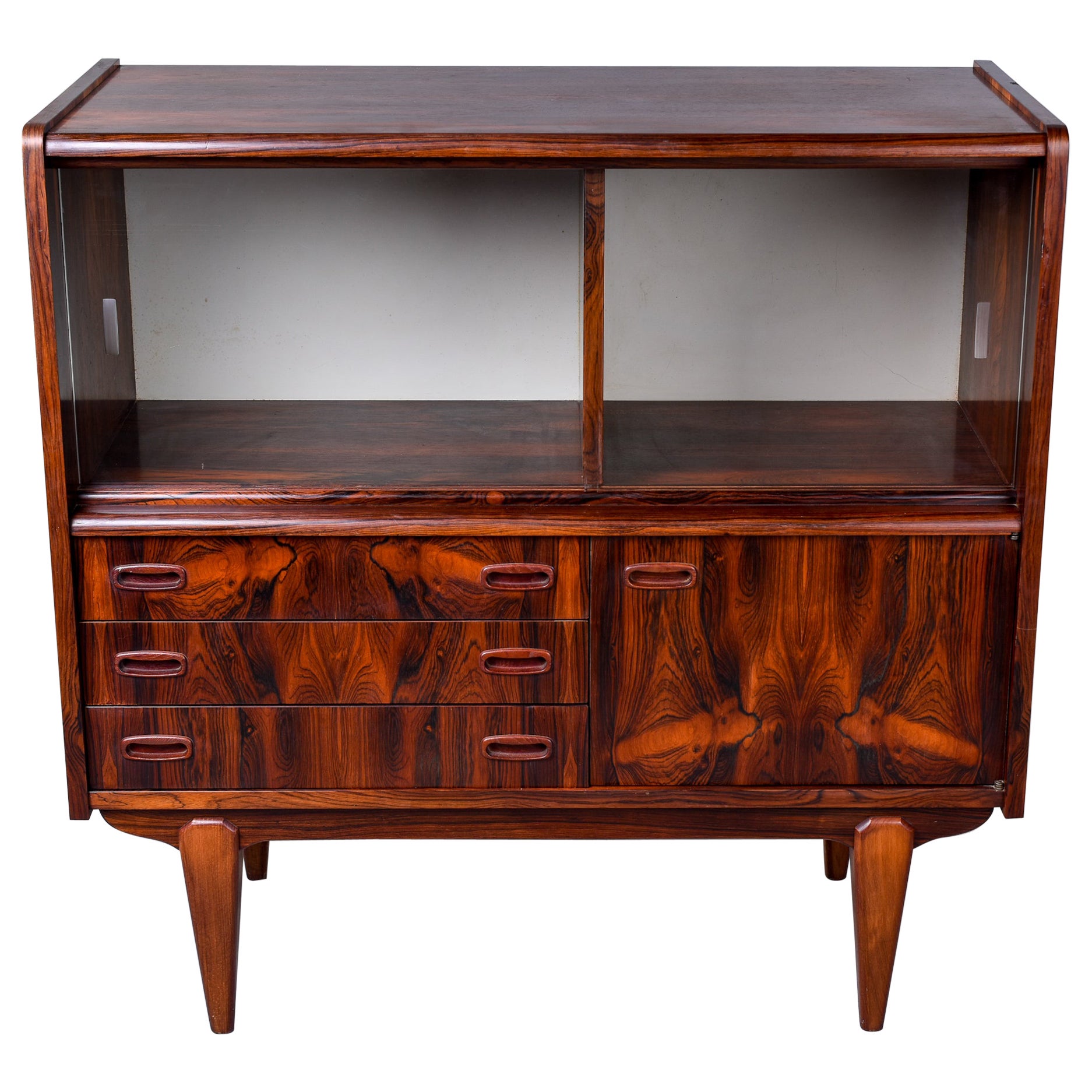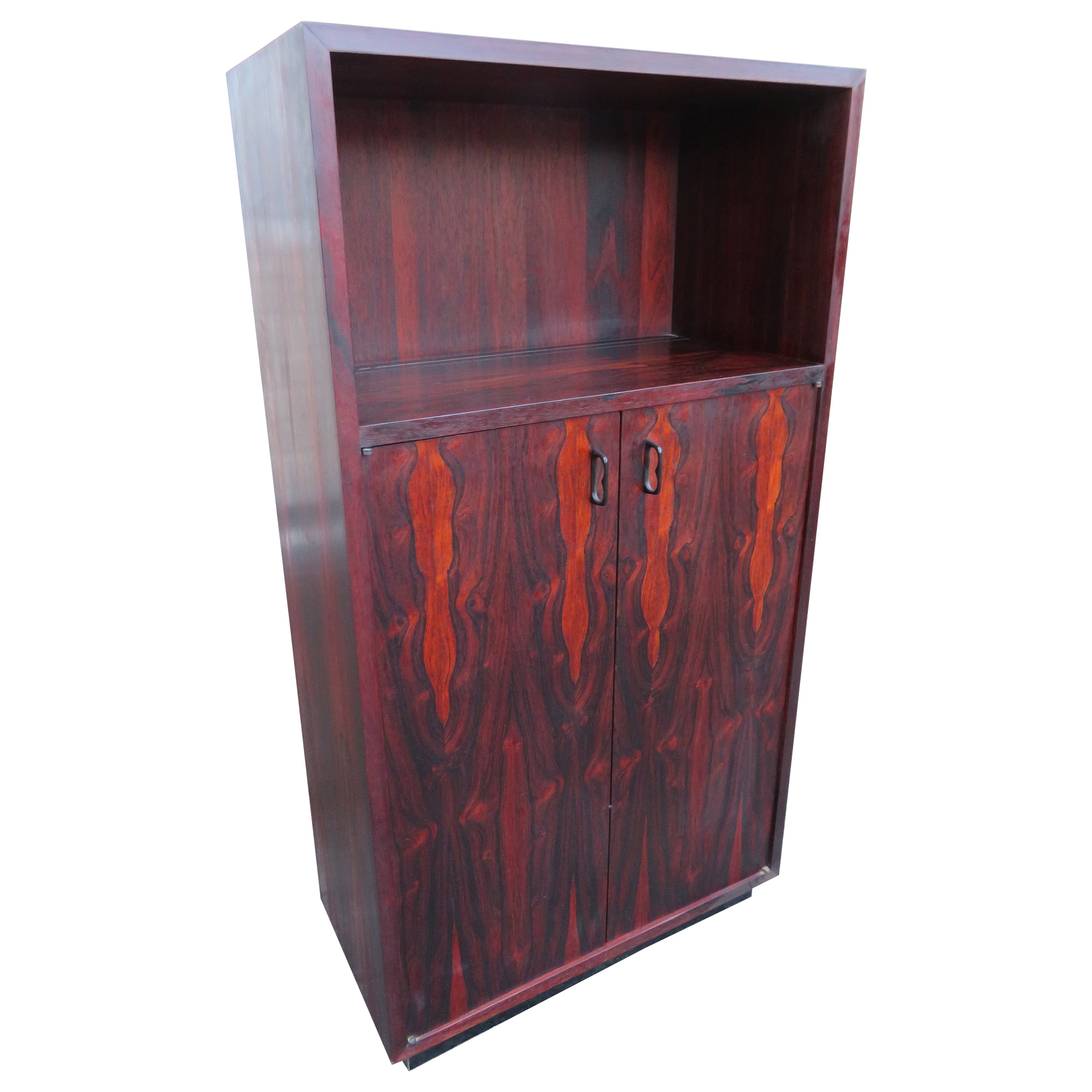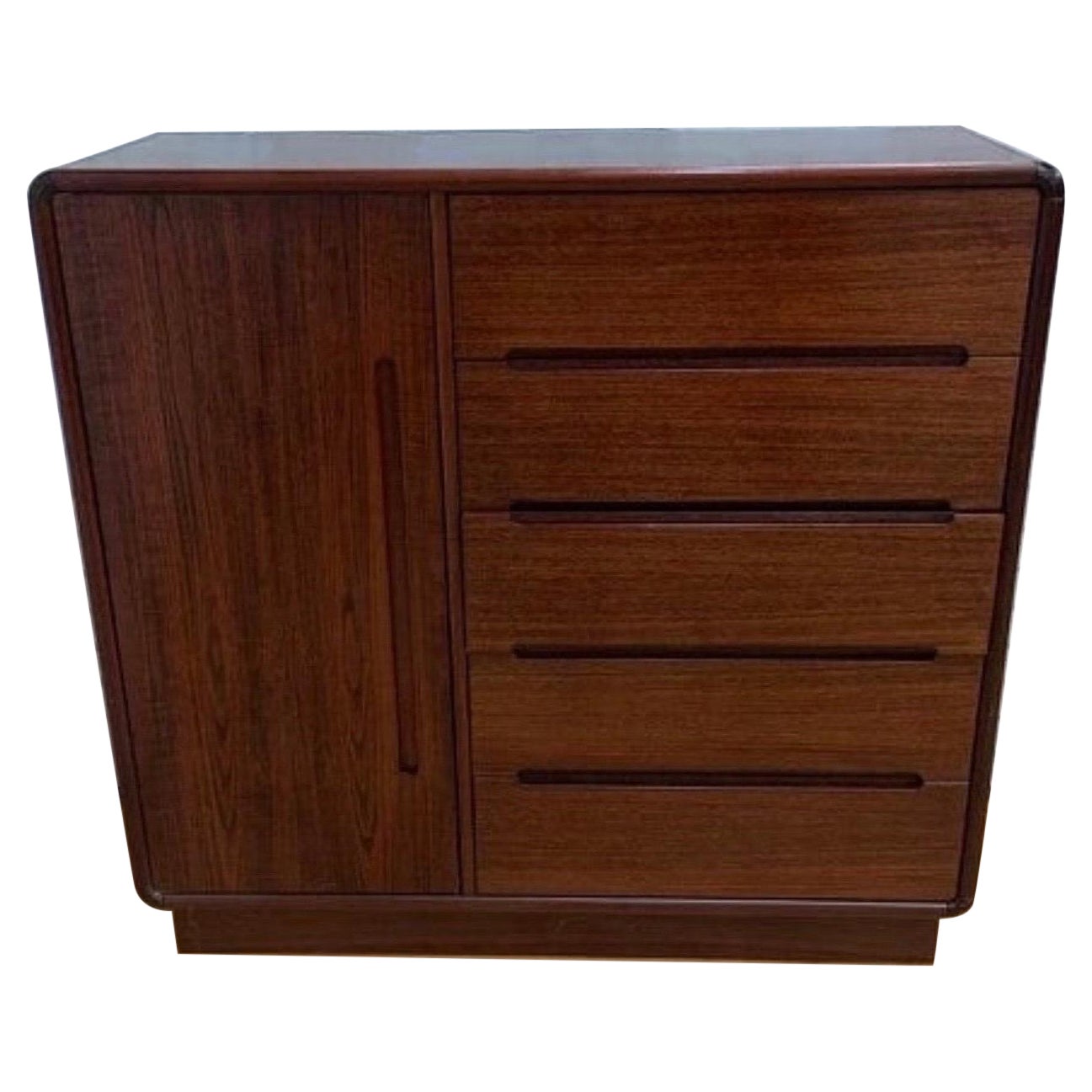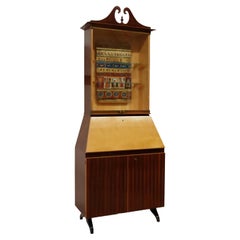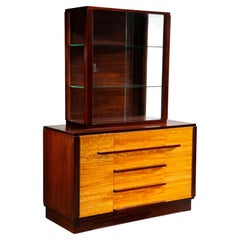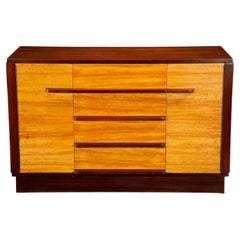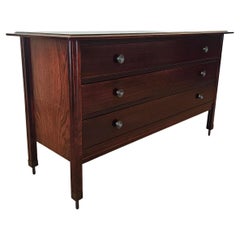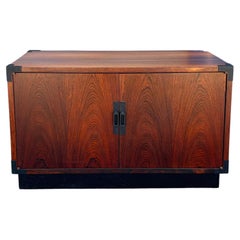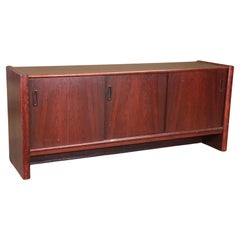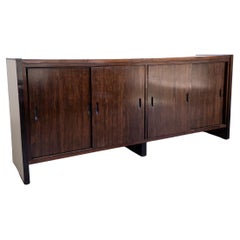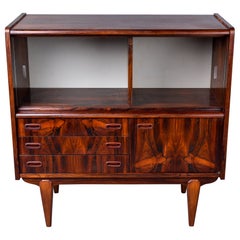Items Similar to Mid-Century Deco Modern Formica Rosewood Cabinet
Want more images or videos?
Request additional images or videos from the seller
1 of 6
Mid-Century Deco Modern Formica Rosewood Cabinet
$3,350
£2,543.73
€2,908.95
CA$4,680.44
A$5,205.67
CHF 2,718.24
MX$63,347.42
NOK 34,716.04
SEK 32,557.52
DKK 21,710.61
Shipping
Retrieving quote...The 1stDibs Promise:
Authenticity Guarantee,
Money-Back Guarantee,
24-Hour Cancellation
About the Item
An impressive, very good quality mid-century cabinet, Art Deco Moderne taste, finished in stunning rosewood with white formica. Two cupboard doors open to spacious interior fitted with single shelf, two large drawers provide generous additional storage, large open niche, upper shelf.
Can be used a variety of ways including as a sideboard server or buffet, dry bar, kitchenette, credenza, media console, etc.
Dimensions (approx):
46" tall x 36.5" wide x 18" deep.
- Dimensions:Height: 46 in (116.84 cm)Width: 36.5 in (92.71 cm)Depth: 18 in (45.72 cm)
- Style:Mid-Century Modern (In the Style Of)
- Materials and Techniques:
- Period:
- Date of Manufacture:circa 1960
- Condition:Wear consistent with age and use.
- Seller Location:Forney, TX
- Reference Number:1stDibs: LU5977227392172
About the Seller
4.8
Platinum Seller
Premium sellers with a 4.7+ rating and 24-hour response times
Established in 2013
1stDibs seller since 2021
294 sales on 1stDibs
Typical response time: <1 hour
- ShippingRetrieving quote...Shipping from: Forney, TX
- Return Policy
Authenticity Guarantee
In the unlikely event there’s an issue with an item’s authenticity, contact us within 1 year for a full refund. DetailsMoney-Back Guarantee
If your item is not as described, is damaged in transit, or does not arrive, contact us within 7 days for a full refund. Details24-Hour Cancellation
You have a 24-hour grace period in which to reconsider your purchase, with no questions asked.Vetted Professional Sellers
Our world-class sellers must adhere to strict standards for service and quality, maintaining the integrity of our listings.Price-Match Guarantee
If you find that a seller listed the same item for a lower price elsewhere, we’ll match it.Trusted Global Delivery
Our best-in-class carrier network provides specialized shipping options worldwide, including custom delivery.More From This Seller
View AllOsvaldo Borsani Mid-Century Modern Italian Bar Cabinet
By Osvaldo Borsani
Located in Forney, TX
Make a statement with this rare mid-century Italian modernist bar cabinet (sideboard buffet) attributed to legendary designer Osvaldo Borsani (Italy, 1911-1985), circa 1950s.
Havi...
Category
Mid-20th Century Italian Mid-Century Modern Dry Bars
Materials
Wood, Rosewood
Art Deco Signed Wolfgang Hoffmann for Romweber World's Fair Display Cabinet
By Wolfgang Hoffmann, Romweber Furniture Co.
Located in Forney, TX
A rare and important Art Deco period Century of Progress Display Cabinet designed by Wolfgang Hoffmann (Austrian, 1900-1969) for Romweber Company, Batesville, Indiana, United States of America. circa 1933-1936
Created for the 1933 Chicago World's Fair, one piece design, having a rectangular showcase top with glass panel sides and a pair of sliding glass doors, over solid wood chest fitted with four drawers affixed with horizontal pulls, flanked by cabinet doors, opening to shelved interior. Rosewood, mahogany, richly figured blonde - golden birch or primavera, and glass.
Signed, original label to drawer interior, featuring 1933 World's Fair mark impressed.
**Please note, at the time of writing this, a matching sideboard - buffet (shown in last photo) is currently available separately**
Provenance / Acquisition:
Property from the important and iconic collection of Mr. James I. Rafftesaeth Jr., Dallas, Texas
Acquired from highly reputable auction house, Heritage Auctions, Dallas, Texas. 2022 Design Signature Auction catalog #8091
History:
Wolfgang Hoffmann was born in Vienna, Austria in 1900. He is the son of famous architect, pedagogue and Wiener Werkstatte cofounder, Joseph Hoffmann (1870-1956). Early on, following his father’s s interests, he was trained in the decorative arts and design. Wolfgang Hoffmann once reminisced, “I spent eight years at the Realschule, then three years went to a special architectural school, where I perfected my technical knowledge of architecture and general construction. From this school, I was graduated to the Kunstgewerbeschule [Studying under Oskar Strnad and Josef Frank in Vienna]. After finishing this school, I had one and a half years of practical in a well known architect’s office. Thereafter I worked in my Father’s office for two years”.
Hoffmann met his future wife, Polish immigrant Pola (1902-1984) when they were both studying at the Kunstgewerbeschule. Joseph Urban (1872-1933) was needing an assistant for his architectural business in New York and contacted his friend and colleague, Joseph Hoffmann in Vienna. Hoffmann recommended his son Wolfgang. Urban hired him and sent a first class passage ticket to Vienna for Wolfgang to travel to New York. Wolfgang married Pola and traded his ticket for two tickets to America in steerage, arriving in New York City in December of 1925.
Leaving the Urban office after nine months, Wolfgang and Pola formed an independent design practice with offices on Madison Avenue in Manhattan with the purpose of creating contemporary interiors and industrial designs. Early work included theaters, stores, and apartments mostly in New York City.
During the late 1920’s and early 1930’s the Hoffmanns designed custom furniture for private clients. Some of these examples were shown in the February 1929 issue of House and Garden. Curiously, the examples’ design was attributed to Urban and the production to Pola Hoffmann, Inc.
Established in the fall of 1928, the American Designers’ Gallery was “devoted exclusively to showing objects and interiors for practical use… by fourteen American architects and designers”. Its members included the Hoffmans and Urban as well as ceramist Henry Varnum Poor (1888-1971), architect Raymond Hood (1881-1934), artist designer Winold Reiss (1886-1953), graphic designer Lucien Bernhard (1896-1981), decorator Donald Deskey (1894-1989), and architect Ely Jacques Kahn (1884-1972).
The Hoffmanns’ work was included in the American Designers’ Gallery’s two showcase events, its 1928 and 1929 exhibitions. Their dining alcove at the 1929 event featured a bench with a dinette table and two chairs in American walnut designed by Wolfgang and a rug by Pola.
Lucien Bernhard, fellow Austrian immigrant who settled in New York a year before the Hoffmanns, operated the gallery and decorating service Contempora with Munich resident Bruno Paul (1874-1968). The Hoffmanns, occasionally participating with Contempora, designed a number of outstanding interiors, including the constructivist living room of 1930 for Mrs. O.R. Sommerich at 40 East 66th street. In 1934, Donald Deskey commissioned Wolfgang to design birchwood furnishings for the eclectic apartment at 625 Park Avenue belonging to Helena Rubinstein.
In 1931, Wolfgang exhibited his work at the Pennsylvania Art Museum and the Museum of Modern Art in New York City. The same year, with Kem Weber (1889-1963) he organized the second and final exhibition of AUDAC- “Modern Industrial and Decorative Arts”- at the Brooklyn Museum. At this event, the Hoffmanns showed the dining room previously included in the American Designer’s Gallery’s 1929 exhibition in the Chase Bank Building lobby at 145 West 57th Street in Manhattan.
In 1932 Wolfgang was asked to assist Urban in developing the color scheme for the 1933-34 Chicago World’s Fair “A Century of Progress”. He was also commissioned to design the interior and furniture for the fair’s lumber industries house. There he executed its living and dining rooms furnished by Kroehler Manufacturing Company of Chicago; the boys’ room by Shower Brothers...
Category
Early 20th Century American Art Deco Vitrines
Materials
Glass, Mahogany, Rosewood
Art Deco Wolfgang Hoffmann Romweber World's Fair Century of Progress Sideboard
By Romweber Furniture Co., Wolfgang Hoffmann
Located in Forney, TX
A rare and important American Art Deco Century of Progress Sideboard by iconic designer Wolfgang Hoffmann (Austrian, 1900-1969) for Romweber Company, Batesville, Indiana. circa 1933-1936
Created for the 1933 Chicago World's Fair, fine quality craftsmanship and construction, having a rectangular exotic rosewood veneered top over conforming solid wood case fitted with four drawers affixed with horizontal pulls, the top drawer opening to reveal felt lined divided interior for silverware, flanked by cabinet doors opening to shelved interior, subtle geometric lines add interest. Rosewood, mahogany, richly figured blonde - golden birch or primavera.
Signed, top drawer interior, featuring 1933 World's Fair mark impressed.
**Please note, at the time of writing this, a matching display case - vitrine cabinet (shown in last photo) is currently available separately**
Provenance / Acquisition:
Property from the important and iconic Collection of Mr. James I. Rafftesaeth Jr., Dallas, Texas
Acquired from highly reputable auction house, Heritage Auctions, Dallas, Texas. 2022 Design Signature Auction catalog #8091
History:
Wolfgang Hoffmann was born in Vienna, Austria in 1900. He is the son of famous architect, pedagogue and Wiener Werkstatte cofounder, Joseph Hoffmann (1870-1956). Early on, following his father’s s interests, he was trained in the decorative arts and design. Wolfgang Hoffmann once reminisced, “I spent eight years at the Realschule, then three years went to a special architectural school, where I perfected my technical knowledge of architecture and general construction. From this school, I was graduated to the Kunstgewerbeschule [Studying under Oskar Strnad and Josef Frank in Vienna]. After finishing this school, I had one and a half years of practical in a well known architect’s office. Thereafter I worked in my Father’s office for two years”.
Hoffmann met his future wife, Polish immigrant Pola (1902-1984) when they were both studying at the Kunstgewerbeschule. Joseph Urban (1872-1933) was needing an assistant for his architectural business in New York and contacted his friend and colleague, Joseph Hoffmann in Vienna. Hoffmann recommended his son Wolfgang. Urban hired him and sent a first class passage ticket to Vienna for Wolfgang to travel to New York. Wolfgang married Pola and traded his ticket for two tickets to America in steerage, arriving in New York City in December of 1925.
Leaving the Urban office after nine months, Wolfgang and Pola formed an independent design practice with offices on Madison Avenue in Manhattan with the purpose of creating contemporary interiors and industrial designs. Early work included theaters, stores, and apartments mostly in New York City.
During the late 1920’s and early 1930’s the Hoffmanns designed custom furniture for private clients. Some of these examples were shown in the February 1929 issue of House and Garden. Curiously, the examples’ design was attributed to Urban and the production to Pola Hoffmann, Inc.
Established in the fall of 1928, the American Designers’ Gallery was “devoted exclusively to showing objects and interiors for practical use… by fourteen American architects and designers”. Its members included the Hoffmans and Urban as well as ceramist Henry Varnum Poor (1888-1971), architect Raymond Hood (1881-1934), artist designer Winold Reiss (1886-1953), graphic designer Lucien Bernhard (1896-1981), decorator Donald Deskey (1894-1989), and architect Ely Jacques Kahn (1884-1972).
The Hoffmanns’ work was included in the American Designers’ Gallery’s two showcase events, its 1928 and 1929 exhibitions. Their dining alcove at the 1929 event featured a bench with a dinette table and two chairs in American walnut designed by Wolfgang and a rug by Pola.
Lucien Bernhard, fellow Austrian immigrant who settled in New York a year before the Hoffmanns, operated the gallery and decorating service Contempora with Munich resident Bruno Paul (1874-1968). The Hoffmanns, occasionally participating with Contempora, designed a number of outstanding interiors, including the constructivist living room of 1930 for Mrs. O.R. Sommerich at 40 East 66th street. In 1934, Donald Deskey commissioned Wolfgang to design birchwood furnishings for the eclectic apartment at 625 Park Avenue belonging to Helena Rubinstein.
In 1931, Wolfgang exhibited his work at the Pennsylvania Art Museum and the Museum of Modern Art in New York City. The same year, with Kem Weber (1889-1963) he organized the second and final exhibition of AUDAC- “Modern Industrial and Decorative Arts”- at the Brooklyn Museum. At this event, the Hoffmanns showed the dining room previously included in the American Designer’s Gallery’s 1929 exhibition in the Chase Bank Building lobby at 145 West 57th Street in Manhattan.
In 1932 Wolfgang was asked to assist Urban in developing the color scheme for the 1933-34 Chicago World’s Fair “A Century of Progress”. He was also commissioned to design the interior and furniture for the fair’s lumber industries house. There he executed its living and dining rooms furnished by Kroehler Manufacturing Company of Chicago; the boys’ room by Shower Brothers...
Category
Early 20th Century American Art Deco Sideboards
Materials
Birch, Mahogany, Rosewood
Midcentury Modern Era Designer Carlo De Carli Sormani Rosewood Chest of Drawers
By Sormani, Carlo De Carli
Located in Forney, TX
A fine quality Italian modern chest of drawers designed by famed architect and designer Carlo de Carli (Milan, Italy; 1910-1999) for luxury furniture maker Sormani, model D154, circa...
Category
Mid-20th Century Italian Mid-Century Modern Commodes and Chests of Drawers
Materials
Bronze
French Art Deco Moderne Exotic Burled Ambroyna Bubinga Thuja Nightstand Cabinets
Located in Forney, TX
A rare and magnificent pair of very fine quality French Art Deco Modernist bedside cabinets attributed to Christian Krass, with design influenc...
Category
Vintage 1930s French Art Deco Night Stands
Materials
Brass
Carrocel Interiors Art Deco Style Figured Walnut Office Desk
By Carrocel
Located in Forney, TX
A high quality custom made walnut contemporary writing desk by luxury furniture maker Carrocel Interiors.
Styled in timeless Art Deco Modern tas...
Category
Late 20th Century Art Deco Desks and Writing Tables
Materials
Walnut
You May Also Like
1960s Mid Century Rosewood Two-Door Cabinet
Located in North Hollywood, CA
Welcome to Mid-Century NoHo
[Mid Century Rosewood Two-Door Cabinet]
This mid-century two-door cabinet, designed and crafted in the United States in the 1960s, showcases a beautiful...
Category
Vintage 1960s American Mid-Century Modern Cabinets
Materials
Rosewood
Rosewood Mid-Century Cabinet
Located in Brooklyn, NY
Long mid-century modern credenza with sliding doors. Open cabinet storage with shelf capability.
Please confirm location NY or NJ
Category
Mid-20th Century Mid-Century Modern Cabinets
Materials
Rosewood
Rosewood Brazilian Cabinet
Located in New York, NY
Oringinal Brazilian Cabinet from the 1960s, made in Rosewood with a White Formica top. Contains two Storage Units with sliding Rosewood doors.
Category
Vintage 1960s Brazilian Mid-Century Modern Cabinets
Materials
Formica, Rosewood
$11,500
Mid Century Scandinavian Rosewood Bar Cabinet with Sliding Glass Doors
Located in Troy, MI
Circa 1970 Scandinavian bar cabinet in dramatically figured rosewood veneer features two sliding glass doors on the top section over three felt lined drawers on one side and a storage compartment with internal shelf on the other. Tapered legs. Unknown maker.
Very good overall vintage condition.
Open Shelf Sections...
Category
Mid-20th Century Scandinavian Mid-Century Modern Dry Bars
Materials
Glass, Rosewood
Jack Cartwright for Founders Brazilian Rosewood Bar Cabinet Mid-Century Modern
By Jack Cartwright, Founders Furniture Company
Located in Pemberton, NJ
Jack Cartwright for Founders Brazilian rosewood bar cabinet. This piece has been well cared for and is in wonderful vintage condition. The rosewood has tons of graning and has a deep...
Category
Vintage 1970s American Mid-Century Modern Cabinets
Materials
Metal
$2,880 Sale Price
20% Off
Mid Century Modern Danish Rosewood Gentleman's Cabinet/Armoire
Located in Chicago, IL
Mid-Century Modern Danish Rosewood Gentleman's Cabinet/Armoire
Gorgeous Mid-Century Modern Danish Rosewood Side By Side Dressing Cabinet/Armoire. This Chest is Beautifully Crafted i...
Category
Mid-20th Century Danish Mid-Century Modern Dressers
Materials
Rosewood
More Ways To Browse
Rosewood Mid Century
Tall Midcentury Storage Cabinet
Mid Century Modern Tall Cabinet
Tall Storage Cabinets Mid Century Modern
Mid Century Formica
Mid Century Modern Formica Furniture
Mid Century Console Cabinets
Media Cabinet Modern
Art Deco White Cabinet
Mid Century Media Cabinet
Vintage Media Storage
Midcentury Modern Bar Sideboard
Mid Century White Sideboard
Brown Formica Cabinet
Niche Cabinet
Mid Century Servers Cabinets
Rosewood Tall Cabinet
Art Deco Rosewood Cabinet
